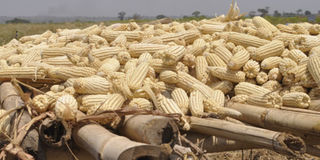Preventing pests

Maize cobs drying on a rack at a farm in Gayaza. Photo by Edgar R Batte
Harvesting period is upon us. What are best practices that keep grains especially maize safe from pests? Andrew Abigaba
Dear Andrew
To begin with, proper sanitation is the foremost aspect in preventive management. To ensure proper hygiene, the threshing floor or yard should be clean and free from insect infestation.
• Harvesting and threshing machines also need to be thoroughly cleaned before use.
• Trucks, trolleys or carts used for transportation of food grains must be cleaned and made free from insect infestation.
• Further, storage structures need to be cleaned properly before the storage of newly harvested produce.
• All dirt, dust, rubbish, sweepings and webbings should be removed from the dryers and stores and destroyed.
• All the cracks, crevices, holes existing on the floors, walls and ceiling should be neatly and permanently plastered with mud or cement.
• Rat burrows, if existing, need to be closed with a mixture of broken glass pieces and mud and then plastered neatly with mud/cement.
• Overall, the grains should be stored in places which are rat and moisture proof.
• Proper stacking of bags also helps in grain protection. During storage, there are curative measures to be followed.
• Non-chemical involve ecological conditions. Temperature, moisture content in the grain and oxygen are required for rapid development and multiplication of insects.
• By proper manipulation and management of these factors through design and construction of storage structures, ecological conditions unfavourable for attack by various insects can be created.
• Temperatures ranging from 20°C to 40°C accelerates the development of insects but above 42°C and below 15°C retards reproduction and development, while prolonged temperature above 45°C and below l0°C may kill the insects.
• Grains stored at around 10 per cent moisture content escape insect-attack.
Mechanical methods are also quite practicable.
Screening out of broken grains reduces chances of insect infestation. Screening should be done regularly and away from the stores to avoid any re-infestation.
Chemical measures of insect-pest management involve usage of pesticides. They are the most popular and perhaps the most effective one in controlling pests.
The term insecticide can be applied to all chemicals used to kill, control or manage insects.
Insecticides capable of immobilising or killing insects quickly are called knockdown chemicals.
Answered by Mike Ssegawa Ssali agronomist
What nutrients do I get by burning cow dung manure? Annet Kabasindi
Dear Annet
When you burn cow dung, nutrients such as nitrogen, sulphur and carbon are lost in gaseous form and this process is what we call volatilization.
The ash that remains contains oxides of: phosphorus, potassium, magnesium, calcium, zinc, boron, sodium, manganese, copper and other elements that are very small in amount.
So when the nitrogen is lost, it gives solid high in phosphorus and potassium in terms of nutrients. This implies that the ratio of NPK will be zero for nitrogen but high for the other two; phosphorus and potassium which is good for chasing away insects as well as treating phosphorus deficiencies.
Answered by Dr Samuel Nsubuga, an agronomist with Smart agribusiness forum Africa




